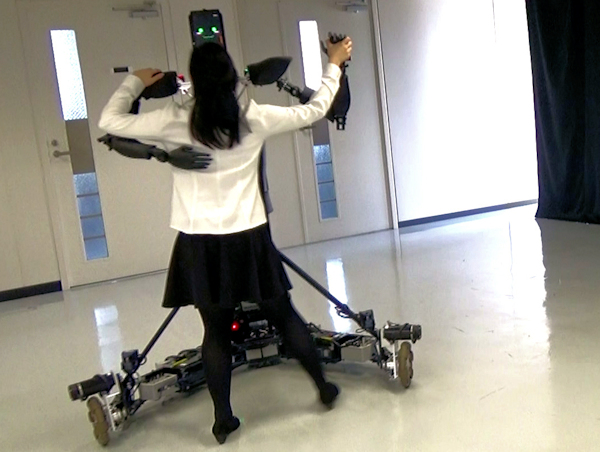[Researchers at Tohoku University have created a robot that teaches people how to dance, which involves not only complex physical interactions but (arguably) medium-as-social-actor presence. The story is from New Scientist, with additional details from coverage by the Daily Mail. For more information see videos from Quartz and the researchers on YouTube, and of course the published paper. –Matthew]

Waltzing robot teaches beginners how to dance like a pro
By Edd Gent
24 May 2017
Got no one to dance with? Not to worry – you might soon be gliding through the moves, thanks to a robotic instructor designed to teach humans how to dance.
The robot’s designers had already created mechanical dance partners that follow a human’s lead, but the new machine gently guides novices through routines while adapting to their skill level.
This is trickier, says Diego Felipe Paez Granados at Tohoku University in Sendai, Japan, who led the research, because the robot must keep students on course without becoming too forceful.
The 1.8-metre-tall robot has wheels, but its upper body moves like that of a human dancer. A force sensor and two laser rangefinders track its student’s movements, which are compared against motion-capture data recorded from professional dancers to judge their performance.
As they progress, the robot gradually reduces the force used to lead them so they become less reliant on its guidance. Its face displays real-time feedback to help pinpoint mistakes, as well as showing them their overall progress to provide encouragement.
In tests with volunteers who had never waltzed before, five out of six improved, according to results to be presented at the International Conference on Robotics and Automation in Singapore later this month. With another group, the robot was not programmed to adapt to students’ progress and four out of six showed no improvement.
Wider applications
Enabling robots to teach humans through physical interaction could have applications beyond dancing, says Paez Granados, from physical rehabilitation to sports training.
“There are special skills and sports where the trainers are not always so open to everyone,” he says. “If you have this system that is good enough to teach you as well as a professional, then it could have a huge market.”
Etienne Burdet, who works on human-machine interaction at Imperial College London, says the underlying approach has already been adopted in robots used in medical rehabilitation – but extending it to complex, full-body interactions such as dancing is an important contribution.
Understanding more free-form physical interact between humans and machines could be important for many applications, including the handover of controls between human drivers and autonomous cars, he adds.
Journal reference: IEEE Robotics and Automation Letters, DOI: 10.1109/LRA.2017.2671428
—
[From the Daily Mail]
Dancing with the BOTS: Bizarre mechanical instructor can guide and teach anyone (just hope it doesn’t tread on your toes)
By Cecile Borkhataria For Dailymail.com
24 May 2017
According to the authors of the study, the bot is designed for contact with adults with heights ranging from 1.5 meters (4 feet 9 inches) to 1.9 meters (6 feet two inches) meters tall.
[snip]
The robot embraces the human with the right arm and contacts the human by the left hand and at the hip level, creating the dance closed position.
The robot’s guidance force isn’t too strong to maintain comfort for the partner, which also makes it easier for them to adapt to the interaction with the robot.
For a partner that has improved, the dance teaching robot reduces the force of its guiding motions, allowing the partner to move more freely by him or herself.
And if the human partner abruptly stops, the robot maintains contact within a limit of force – and when the partner starts moving again, the robot continues to guide.
To test the relationship between the student and the bot, researchers recruited 12 volunteers who were all novices in the Waltz dance.
The volunteers first observed an experienced dancer performing the steps.
Since the robot lacks feet, an example of a human performing the feet motions was preferable.
Then, the volunteers observed the robot performing the dance figures alone to help them understand the robot’s motion in relation to the steps.
They then interacted with the robot for the first time, adapting to the bot’s height and arms position.
The volunteers were then asked to stop moving while practicing to test the force of the robot, allowing them to gain more trust in the robot as they became aware that the robot’s motions depend on their response.
They practiced with the robot in a session lasting 20 to 30 minutes long, and then filled out a questionnaire to evaluate their perception of the session.